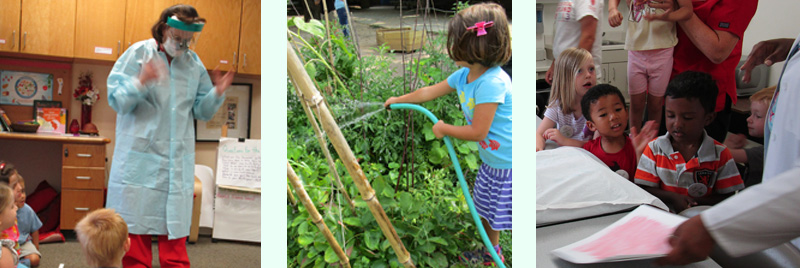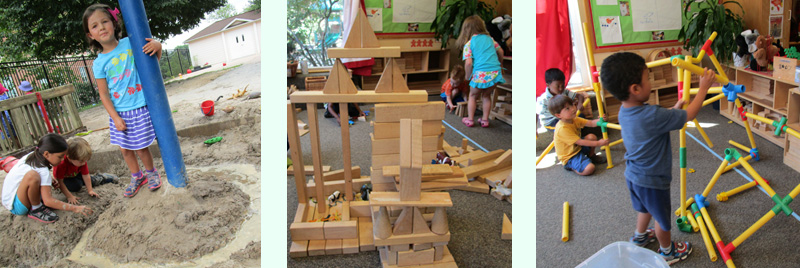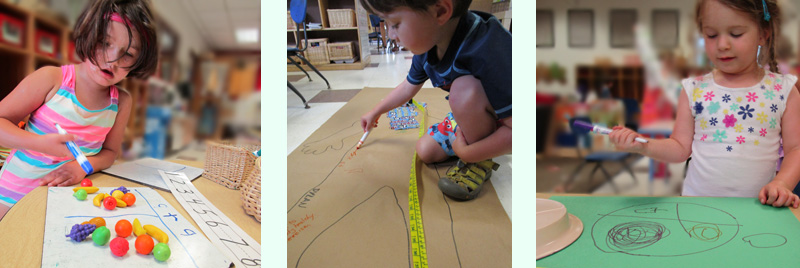

What is STEM? STEM is an acronym for science, technology, engineering and mathematics. In the future jobs in these areas are projected to grow and the Department of Education has set a priority to focus on these domains. In 2010 the White House launched it's "Educate to Innovate" campaign with emphasis on STEM subjects.
How does this translate to preschoolers, particularly in a summer "healthy body" project?

Learning about healthy bodies is encompassed in biology and the life sciences. Because every child has a body, they are naturally interested in the topic. You can see by the many questions generated during week two the myriad of things the children are curious about. Children explored what foods it takes to keep a body healthy, what vitamins and minerals they need and how these are printed on the labels of the foods they eat. The insides of the body was investigated during the summer, from muscles to the digestive system. Dr. Baker used models and real items to teach about teeth and how to care for them. Children learned about vegetables by planting bean seeds, taking care of a garden and visiting a farmers market to see what varieties are available. Twice the children were involved in experiments to show how microscopic germs are transferred to items, learning first hand ,how important it is to thoroughly wash hands.
Many children's non-fiction books on the body have been printed in recent years. They were read during meeting, during center time, and for nap. The beautiful graphics and easy text helped open new concepts to the children such as how blood moves around your body, why sleep is important, and what it's like to visit a dentist.

"We need to get a computer out to help us find the answers to our questions," remarked one child. From playing with broken computers and phones in dramatic play to photographing activities for documentation and display, to preparing a video presentation using an iPad for families to view, campers were immersed in technology during the summer.

Typically, engineering in preschool shows itself in the unit block center where children build structures using carefully crafted blocks that are proportional in size to each other. This went on in the Red Room everyday, unrelated to the overall Human Body study. Campers worked diligently often with partners to balance and construct buildings that were stable and adaptive to the play intended. Water and sand were frequently used on the playground to make moats and lakes that held water in specific forms. Children collaborated for extended periods to get water to flow and stand in designated areas. In the image above left, children are working together to construct a building. When the building leaned against the guinea pig cage, children discussed how to correct the problem and it was decided they needed an extra curved connector.
The mechanics of muscles, joints and bones and how they work together was part of several lessons during the summer. Puzzles showed how the different parts are layered and connect in the body. Children drew some of these body parts and systems on body tracings to get a feel for how it all went together.

Math is included throughout the curriculum. When talking about nutrition it was learned that we need to eat at least 5 fruits and vegetables a day. With the aid of a dry erase board and some math manipulatives, children were able to add up the amount of fruits and vegetables they had eaten and subtract to see how many more they might need to eat for dinner or how many over and above the 5 they had eaten.
Measuring and weighing are natural math processes to use when learning about bodies. Feet, arms, hands and whole bodies were measured using standard and non-standard measurements. "How many star builder links long is your arm?" was a question that came up and was resolved. In this way children get practice in counting and observing the quantity of things using materials they understand. Fractions were touched upon when learning about MyPlate. Campers designed their own place mats with the MyPlate pattern and divided the plate into four appropriate sections.
How many bones are in your body? How many muscles? These were questions that were answered in some of the expository books read in the classroom. How do you visualize such numbers? Multiple hundred charts were used to visually show the children what 200 looks like. Campers had the opportunity to cover the grid on the 100 charts with small objects to help them grasp how much 100 is.

This is just a sampling of how these domains were addressed over the 6 week summer camp study. Below are links to helpful articles on STEM in early childhood.
Helpful Links About STEM
NAEYC Technology and Young Children
Nurturing STEM skills in Young Learners